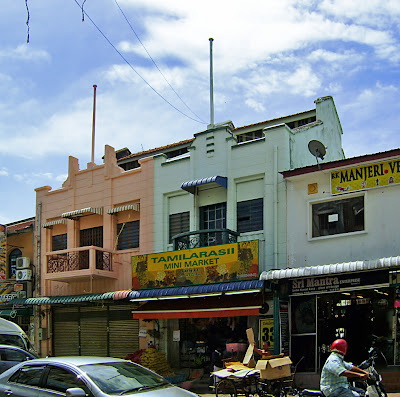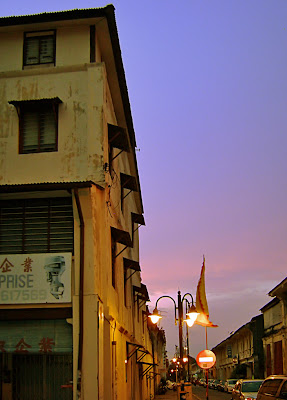Little India within the Heritage Core Zone of Georgetown Penang is home to many pre-war heritage shophouses. However, most of them do not catch the eye of the casual observer (well, at least not to my eyes). I blame on the fact that the stuff on display at the Indian shops are so bright and eye-catching. It doesn't help that your ears are assaulted with a bewildering ensemble of religious Aums (Om - ओं) and Indian pop songs that blare out from every corner. There is just no escape from them, and coupled with the cacophony of blaring motorcycle and car horns that try to get through the jammed street; you will probably be dizzy like a cow the second you step into Little India to take notice of any of the buildings.
Then there are the signboards...Gaudy like temple jewellery, bold like beautiful saris and steamy like sexy ladies that man the shops. And if you get past all of those distractions, the smell of Little India will surely get to you.
Benzoin and frankincense at one moment, coconut oil with overtones of Sambac jasmine the next, curry and spices after that. Combine all of that and you will get a sensory overload that takes your mind away from observing the rich architectural mélange of that area. So most visitors would focus on the shopping and the saris, the spices and and spicy men, flower garlands so lovely, and the ladies who are more than happy to have visitors step to their shops.
 |
| The signs are big, bright and bombastic. One could almost be fooled into thinking that the shops are merely signboards stacked together! |
Benzoin and frankincense at one moment, coconut oil with overtones of Sambac jasmine the next, curry and spices after that. Combine all of that and you will get a sensory overload that takes your mind away from observing the rich architectural mélange of that area. So most visitors would focus on the shopping and the saris, the spices and and spicy men, flower garlands so lovely, and the ladies who are more than happy to have visitors step to their shops.
Well, for a moment I managed to go beyond those distractions...and something very fundamental caught my eye. The feeling can perhaps be best described as an epiphany, somewhat like Buddha under the Bo tree, except that this was tiny microscopic in scale. It couldn't be, for the colours...but then it has to be. Not one, but a pair of Art-Deco shophouses... Now before you give me a Homer Simpson grunt (D'oh!), take a look at the picture below and tell me what you think of it.
 |
| Two Art-Deco facade shophouses in Little India, Penang. These are along Market Street. One of them is a mini market called Tamilarasi (No. 33). |
No. 33 Market Street is home to Tamilarasii Mini Market, a typical Indian sundry shop whilst its neighbour has no signboard of any sorts and the shutters are down. One green, one orange…the funky colours reminds me of banana leaf and curry...or tumeric. Just look at the sacks of potatoes and onions on the left hand side of the shophouse (adjacent to the orange neighbour) and think of how many pots of curry that would make.
Typical of Art-Deco styled shophouses, lines and geometric design mark the facade. Because it is built with reinforced concrete, there are cantilever sections and in this example, were made into functional balconies. And something that I find very kitsch on many of the Art-Deco shophouses is the centrally placed ‘flag-post thingy’ at the top of the facade (most likely to be concrete). Think of Central Market in Kuala Lumpur, the old OCBC building or even the Rio Hotel at King's Street, Penang and you can surely picture the kooky 'flag-post thingy' I am referring to. The only thing (there is another actually) that isn't typical here of a Penang Art-Deco shophouse is its colour. Instead of Shanghai grey or buff-coloured, it is a bright lime green and its neighbour, a pastel orange colour. Well, if it isn't coloured so it wouldn't qualify as part of Little India, would it?
The other atypical thing with these two lies in the fact that in Penang, the Art-Deco style is commonly seen in large buildings tenanted by banks and associations. Hence I like to consider these two as a sort of an anomaly. The use of metal grille balustrade is not surprising, for the Hui An Association Building, a well-known Art-Deco building dated 1938, also has concrete cantilevered slabs with metal grille balustrade as balconies. If my memory serves me correctly, Campbell Street, which lies in the Buffer Zone, has a number of these small Art Deco shophouses as well. They are not in grey, but definitely not as brightly coloured as these two in Little India.
The other atypical thing with these two lies in the fact that in Penang, the Art-Deco style is commonly seen in large buildings tenanted by banks and associations. Hence I like to consider these two as a sort of an anomaly. The use of metal grille balustrade is not surprising, for the Hui An Association Building, a well-known Art-Deco building dated 1938, also has concrete cantilevered slabs with metal grille balustrade as balconies. If my memory serves me correctly, Campbell Street, which lies in the Buffer Zone, has a number of these small Art Deco shophouses as well. They are not in grey, but definitely not as brightly coloured as these two in Little India.
Map for the location of Tamilarasi Mini Market in Little India, Penang.
So the next time you step into Little India in Penang, stop looking at the saris, stop looking at the spicy Indian men I mean spices and the Indian men that sells them, and stop looking at flowers and the girls who are wearing them. Go beyond the reverberating Aums and brain pounding hip-hop music, the horns and the shouts of petty traders...and see a part of Little India that many miss - funky coloured Art-Deco shophouses that stand out from the rest.
P.S. - When I spotted these Art Deco shophouses in Little India, I now dare say that within the area of Little India, one can catch sight of all the shophouse architectural styles of Penang, starting from the Early Penang Style up to the Early Modernism Style. That is if you can get past the distractions mentioned above, plus massive signboards that cover the facade and flamboyant paint jobs that can best be described as capable of making Elton John blush.
P.S. - When I spotted these Art Deco shophouses in Little India, I now dare say that within the area of Little India, one can catch sight of all the shophouse architectural styles of Penang, starting from the Early Penang Style up to the Early Modernism Style. That is if you can get past the distractions mentioned above, plus massive signboards that cover the facade and flamboyant paint jobs that can best be described as capable of making Elton John blush.














